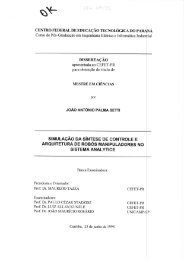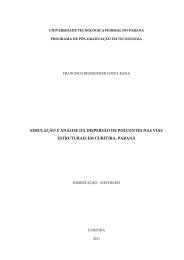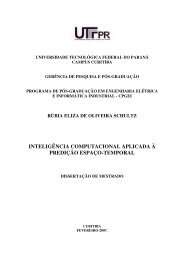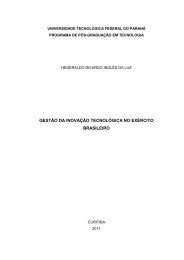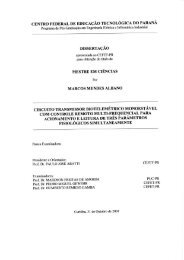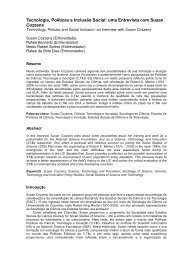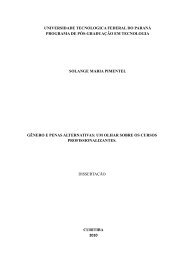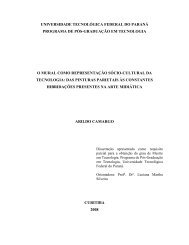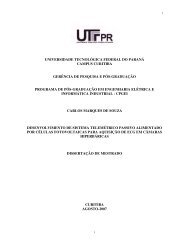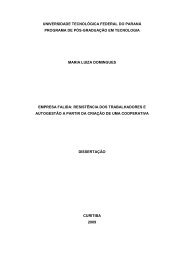F224d Faria, Rubens Alexandre de Desenvolvimento de ... - UTFPR
F224d Faria, Rubens Alexandre de Desenvolvimento de ... - UTFPR
F224d Faria, Rubens Alexandre de Desenvolvimento de ... - UTFPR
Create successful ePaper yourself
Turn your PDF publications into a flip-book with our unique Google optimized e-Paper software.
AAM<br />
11<br />
Timer 0 and 1<br />
Timer 0 and Timer 1 in the AT89C52 operate the same way<br />
as Timer 0 and Timer 1 in the AT89C51.<br />
Timer 2<br />
Timer 2 is a 16-bit Timer/Counter that can operate as either<br />
a timer or an event counter. The type of operation is<br />
selected by bit C/T2 in the SFR T2CON (shown in Table 2).<br />
Timer 2 has three operating mo<strong>de</strong>s: capture, auto-reload<br />
(up or down counting), and baud rate generator. The<br />
mo<strong>de</strong>s are selected by bits in T2CON, as shown in Table 3.<br />
Timer 2 consists of two 8-bit registers, TH2 and TL2. In the<br />
Timer function, the TL2 register is incremented every<br />
machine cycle. Since a machine cycle consists of 12 oscillator<br />
periods, the count rate is 1/12 of the oscillator fre-<br />
quency.<br />
le 3. Timer 2 Operating Mo<strong>de</strong>s<br />
RCLK +TCLK CP/RL2 TR2 MODE<br />
0 0 1 16-Bit Auto-Reload<br />
0 1 1 16-Bit Capture<br />
1 X 1 Baud Rate Generator<br />
X X 0 (Off)<br />
In the Counter function, the register is incremented in<br />
response to a 1-to-0 transition at its corresponding external<br />
input pin, T2. In this function, the external input is sampled<br />
during S5P2 of every machine cycle. When the samples<br />
show a high in one cycle and a low in the next cycle, the<br />
count is incremented. The new count value appears in the<br />
register during S3P1 of the cycle following the one in which<br />
the transition was <strong>de</strong>tected. Since two machine cycles (24<br />
oscillator periods) are required to recognize a 1-to-0 transition,<br />
the maximum count rate is 1/24 of the oscillator frequency.<br />
To ensure that a given level is sampled at least<br />
once before it changes, the level should be held for at least<br />
one full machine cycle.<br />
Capture Mo<strong>de</strong><br />
In the capture mo<strong>de</strong>, two options are selected by bit<br />
EXEN2 in T2CON. If EXEN2 = 0, Timer 2 is a 16-bit timer<br />
or counter which upon overflow sets bit TF2 in T2CON.<br />
This bit can then be used to generate an interrupt. If<br />
EXEN2 = 1, Timer 2 performs the same operation, but a 1-<br />
to-0 transition at external input T2EX also causes the current<br />
value in TH2 and TL2 to be captured into RCAP2H and<br />
RCAP2L, respectively. In addition, the transition at T2EX<br />
causes bit EXF2 in T2CON to be set. The EXF2 bit, like<br />
TF2, can generate an interrupt. The capture mo<strong>de</strong> is illustrated<br />
in Figure 1.<br />
Auto-Reload (Up or Down Counter)<br />
Timer 2 can be programmed to count up or down when<br />
configured in its 16-bit auto-reload mo<strong>de</strong>. This feature is<br />
invoked by the DCEN (Down Counter Enable) bit located in<br />
the SFR T2MOD (see Table 4). Upon reset, the DCEN bit<br />
is set to 0 so that timer 2 will <strong>de</strong>fault to count up. When<br />
DCEN is set, Timer 2 can count up or down, <strong>de</strong>pending on<br />
the value of the T2EX pin.<br />
Figure 1. Timer in Capture Mo<strong>de</strong><br />
OSC + 12<br />
C/T2 = 0<br />
0 -r0<br />
TH2<br />
TL<br />
TF2<br />
C/T2 = 1<br />
CONTROL<br />
TR2<br />
OVERFLOW<br />
T2 PIN<br />
TRANSITION<br />
DETECTOR<br />
CAPTURE<br />
RCAP2H RCAP2L<br />
•<br />
TIMER 2<br />
INTERRUPT<br />
T2EX PIN I 1<br />
EXF2<br />
CONTROL<br />
EXEN2<br />
4-66 AT89C52



